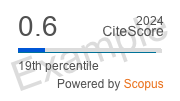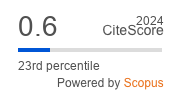ECHOCARDIOGRAPHY-BASED STRUCTURAL AND FUNCTIONAL FEATURES AND INDICATORS OF THE LEFT VENTRICULAR DEFORMATION IN ATHLETES
https://doi.org/10.29001/2073-8552-2019-34-1-48-53
Abstract
Objective: To study the effect of intense physical exertion on the normal physiology of the left ventricle (LV).
Material and Methods. 146 professional athletes underwent a non-invasive assessment of LV systolic deformity in various directions. As a control group, 22 bowling athletes were surveyed.
Results. In cyclists, eccentric hypertrophy of the LV myocardium was detected in 31.7% of men and in 29.5% of women. The values of global longitudinal strain were below 18% in male athletes from the cycling-BMX and cycling-highway groups (17.70±2.40% and 17.50±2.39%, respectively). Indicators of circular apical and circular global deformation were significantly lower in the group of cycling-BMX (men) compared with the corresponding values in the bowling group (14.50±6.23% and 14.70±6.42%; 18.40±6.32% and 16.90±6.43%, respectively, p<0.01).
About the Authors
O. A. DrobyazkoRussian Federation
Physician, Department of Functional and Ultrasound Diagnostics,
28, Orekhovyy blvd., Moscow, 115682
O. S. Chumakova
Russian Federation
leading researcher of the laboratory of genetics, 28, Orekhovyy blvd., Moscow, 115682;
Cardiologist, Department of Therapy, Cardiology and Functional Diagnostics with a Course of Nephrology, 19, bldg 1A, Marshal Timoshenko str., Moscow, 121359
D. A. Zateishikov
Russian Federation
Ph.D., Professor, Leading Researcher, Laboratory of Genetics, 28, Orekhovyy blvd., Moscow, 115682;
Head of the Department of Therapy, Cardiology and Functional Diagnostics with a course of nephrology, 19, bldg 1A, Marshal Timoshenko str., Moscow, 121359
E. G. Chelombitko
Russian Federation
Cardiologist, Cardiology Department, Cardiac Rhythm Disorders,
28, Orekhovyy blvd., Moscow, 115682
M. N. Alekhin
Russian Federation
Professor of the Therapy, Cardiology and Functional Diagnostics Department with a Course of Nephrology, 19, bldg 1A, Marshal Timoshenko str., Moscow, 121359;
Ph.D., Head of the Functional Diagnostics Department, 15, Marshal Timoshenko str., Moscow, 121359
References
1. Solodkov A.S., Sudzilovsky F.V. Adaptive and morpho-functional changes in the body of athletes. Theory and practice of physical culture. 1996;7:44–48 (In Russ.).
2. King G., Wood M.J. The heart of the endurance athlete assessed by echocardiography and its modalities: “embracing the delicate balance”. Curr. Cardiol. Rep. 2013;15(8):383. DOI: 10.1007/s11886-013-0383-1.
3. Fagard R.H. Athlete’s heart. Heart. 2003;89(12):1455–1461.
4. Barbier J., Ville N., Kervio G., Walther G., Carré F. Sports-specific features of athlete’s heart and their relation to echocardiographic parameters. Herz. 2006;31(6):531–543.
5. Kovacs R., Baggish A.L. Cardiovascular adaptation in athletes. Trends Cardiovasc. Med. 2016;26(1):46–52.
6. Rawlins J., Bhan A., Sharma S. Left ventricular hypertrophy in athletes. Eur. J. Echocardiography. 2009;10:350–356.
7. Khadzegova A.B., Yushchuk E.N., Sinitsyna I.A., Shupenina E.Yu., Khuchinaeva A.M., Nadina E.V. New possibilities for assessing the functional state of the heart in arterial hypertension. SonoAce Ultrasound. 2012;24:46–51 (In Russ.).
8. Marwick T.H., Gillebert T.C., & G.A. Recommendations on the Use of Echocardiography in Adult Hypertension. JASE, 2015;28(7):1–12.
9. Lang R.M., Badano L.P., Mor-Avi V., Afilalo J., Armstrong A., Ernande L., et al. Recommendations for Cardiac Chamber Quantification by Echocardiography in Adults: An Update from the American Society of Echocardiography and the European Association of Cardiovascular Imaging. JASE. 2015;28(1):1–39. DOI: 10.1016/j. echo.2014.10.003.
10. Mitchell J.H., Haskell W., Snell P., Van Camp S.P. Task Force 8: classification of sports. J. Am. Coll. Cardiol. 2005;45(8):1364–1367.
11. Santoro A., Alvino F., Antonelli G., Caputo M., Padeletti M., Lisi M., et al. Endurance and strength athlete’s heart: analysis of myocardial deformation by speckle tracking echocardiography. J. Cardiovasc. Ultrasound. 2014;22(4):196–204.
12. Donal E., Rozoy T., Kervio G., Schnell F., Mabo P., Carré F. Comparison of the heart function adaptation in trained and sedentary men after 50 and before 35 years of age. Am. J. Cardiol. 2011;108(7):1029– 1037.
13. Cote A.T., Bredin S.S., Phillips A.A., Koehle M.S., Glier M.B., Devlin A.M., et al. Left ventricular mechanics and arterial-ventricular coupling following high-intensity interval exercise. J. Appl. Physiol. 2013;115(11):1705–1713.
Review
For citations:
Drobyazko O.A., Chumakova O.S., Zateishikov D.A., Chelombitko E.G., Alekhin M.N. ECHOCARDIOGRAPHY-BASED STRUCTURAL AND FUNCTIONAL FEATURES AND INDICATORS OF THE LEFT VENTRICULAR DEFORMATION IN ATHLETES. Siberian Journal of Clinical and Experimental Medicine. 2019;34(1):48-53. (In Russ.) https://doi.org/10.29001/2073-8552-2019-34-1-48-53




.png)





























